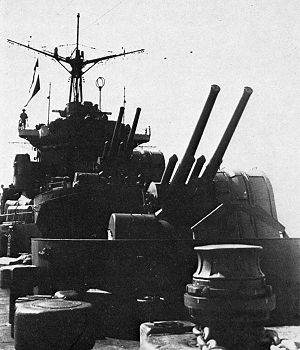You can help expand this article with text translated from the corresponding article in Japanese. (February 2022) Click [show] for important translation instructions.
|
The 12.7 cm/40 Type 89 naval gun (40 Kokei Hachikyu Shiki 12 Senchi 7 Kokakuho) was a Japanese anti-aircraft (AA) gun introduced before World War II. It was the Imperial Japanese Navy's standard heavy AA gun during the war.
| 12.7 cm/40 Type 89 naval gun | |
|---|---|
 Type 89 gun mounted on Chitose | |
| Type | Naval gun anti-aircraft gun |
| Place of origin | |
| Service history | |
| In service | 1932–45 |
| Used by | |
| Wars | World War II |
| Production history | |
| Designed | 1928–32 |
| Produced | 1932–45 |
| No. built | ~1500 |
| Variants | Type 88 |
| Specifications | |
| Mass | 3,100 kilograms (6,834 lb) |
| Barrel length | 5,080 millimeters (16 ft 8 in) (bore length) |
| Shell | Fixed 127 x 580mm .R |
| Shell weight | 20.9–23.45 kilograms (46.1–51.7 lb) |
| Caliber | 12.7-centimeter (5.0 in) |
| Breech | horizontal breech block |
| Elevation | -8° to +90°[1] |
| Rate of fire | 8-14 rounds per minute |
| Muzzle velocity | 720–725 meters per second (2,360–2,380 ft/s) |
| Maximum firing range | 9,440 meters (30,970 ft) at 90° (AA ceiling)
14,800 meters (48,600 ft) at 45° |
The Type 89 was adopted by the IJN on February 6, 1932, and was the primary anti-aircraft gun on new aircraft carriers, battleships and cruisers, most commonly installed in twin gun mounts. It was used as the primary armament of the Matsu-class destroyers. As IJN ships were upgraded in the 1930s and 1940s, older AA guns such as 8 cm/40 3rd Year Type naval gun and 12 cm/45 10th Year Type naval guns were replaced with Type 89s.
Notes edit
- ^ Campbell, Naval Weapons of WWII, p.193.
References edit
- Campbell, John (1985). Naval Weapons of World War Two. Annapolis, Maryland: Naval Institute Press. ISBN 0-87021-459-4.
External links edit
Wikimedia Commons has media related to Type 89 12.7cm AA Gun.